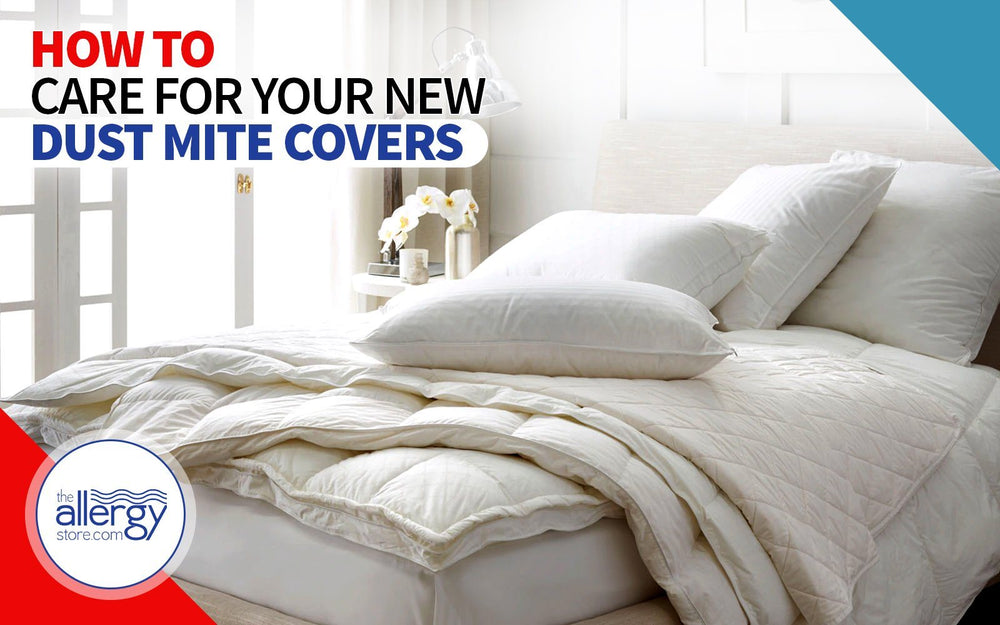
Now that you have taken the step to deal with your allergies, from dust mites and other allergens with dust mite proof covers, you need to know how to take care of them. Don't worry, it really is no hassle. It's easy!
In general, mattress protectors can all be machine washed and dried, just like the rest of your bedding.
First of all your dust mite covers do not need to be washed before they are put on for the first time unless you just want to. None of the covers we sell are treated with any antimicrobial products. Some companies treat their fabrics with different chemicals. We do not.
Also, there is also no need to clean your mattress or pillows before you put the covers on. Some of our customers prefer to vacuum the mattress but it is not necessary. Whatever is in the bed or pillows will stay there once they are covered.
How Often Should Covers Be Washed
The dust mite covers on the mattress only need to be washed once or twice a year unless something is spilled on them. If the covers are for a child with dust mite allergies and the child still has accidents every so often then the mattress covers will need to be washed as needed.
You will want to wash the pillow covers more often. We wash ours about every 4 to 6 weeks. Just take them off and wash them when you wash your sheets.
Vinyl box spring covers require even less maintenance, just wipe the cover down with a damp cloth whenever you flip or turn your mattress. If you are using the SMS mattress cover for the box springs there is nothing to do.
Duvet and comforter covers should be washed as needed. We wash our cover about every 6 to 8 weeks. Once again only when needed. We also spray our comforter once a month the ADMS spray.
If you have a comforter you sleep with and do not have a dust mite cover you may want really want to consider getting one. We found it's cheaper to get a cover than it is to clean a down or wool comforter. It costs us about $60 to have our wool comforter cleaned.
How to Wash Your Mattress Protector
All allergy mattress covers, microfiber, membrane fabrics and waterproof, can be washed in hot water, but we recommend using warm water. What we find is that most residential hot water heaters are set around 105 to 108 for safety reasons.
Personally we use warm water and use either the Demite Laundry Additive or Allersearch Allergen Wash laundry detergent when we wash our covers. Our hot water does not get hot enough anyway. Plus hot water in general causes fabric to wear out faster.
Make sure the zipper is zipped before placing the mattress cover in the washing machine. Wash them on the gentle or regular cycle. Do not use any chlorine bleach or fabric softener when washing the cover.
Why? Bleach is highly caustic. This is how it gets whites so bright. For people with allergies, asthma, or MCS, bleach can sometimes cause more problems than it's worth. This is mainly due to the fumes that come from the bleach. They can trigger reactions, particularly for those with asthma.
Personally we use Clearly Clean Oxygen Whitener, a non-bleach product that uses sodium percarbonate to remove stains.
When you remove the mattress protectors from the washing machine make sure all the water is out of the cover or you and the floor may get wet. The membrane fabric covers being waterproof may hold water if you didn't zip it closed.
Tumble dry on a medium setting. If you take them to a commercial laundry do not dry on high. Some of the dryers get over 140 degrees and that will damage the dust mite cover. No need to iron.
All dust mite mattress protectors can be hand washed and hung to dry but remember anything hung outside will be exposed to dust, pollen and grasses. Please make sure your allergy covers are completely dry before you put them on your mattress, pillows or comforter.
Want to know how to put your mattress cover on the bed? Here is a video that shows you how easy it is.
Additional Reading
Can Dust Mite Covers Provide Relief for Dry, Itchy Skin

